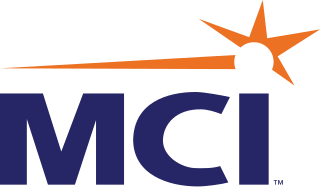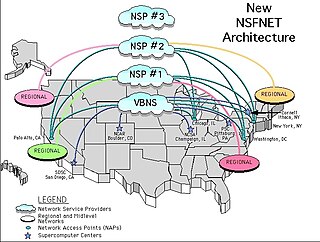
The history of the Internet has its origin in the efforts of scientists and engineers to build and interconnect computer networks. The Internet Protocol Suite, the set of rules used to communicate between networks and devices on the Internet, arose from research and development in the United States and involved international collaboration, particularly with researchers in the United Kingdom and France.
In computer networking, peering is a voluntary interconnection of administratively separate Internet networks for the purpose of exchanging traffic between the "down-stream" users of each network. Peering is settlement-free, also known as "bill-and-keep" or "sender keeps all", meaning that neither party pays the other in association with the exchange of traffic; instead, each derives and retains revenue from its own customers.

The Internet backbone may be defined by the principal data routes between large, strategically interconnected computer networks and core routers of the Internet. These data routes are hosted by commercial, government, academic and other high-capacity network centers, as well as the Internet exchange points and network access points, that exchange Internet traffic between the countries, continents, and across the oceans. Internet service providers, often Tier 1 networks, participate in Internet backbone traffic by privately negotiated interconnection agreements, primarily governed by the principle of settlement-free peering.

A Tier 1 network is an Internet Protocol (IP) network that can reach every other network on the Internet solely via settlement-free interconnection. Tier 1 networks can exchange traffic with other Tier 1 networks without paying any fees for the exchange of traffic in either direction. In contrast, some Tier 2 networks and all Tier 3 networks must pay to transmit traffic on other networks.

An Internet service provider (ISP) is an organization that provides services for accessing, using, managing, or participating in the Internet. ISPs can be organized in various forms, such as commercial, community-owned, non-profit, or otherwise privately owned.
The National Science Foundation Network (NSFNET) was a program of coordinated, evolving projects sponsored by the National Science Foundation (NSF) from 1985 to 1995 to promote advanced research and education networking in the United States. The program created several nationwide backbone computer networks in support of these initiatives. Initially created to link researchers to the NSF-funded supercomputing centers, through further public funding and private industry partnerships it developed into a major part of the Internet backbone.

MCI Communications Corporation was a telecommunications company headquartered in Washington, D.C. that was at one point the second-largest long-distance provider in the United States.

UUNET, founded in 1987, was one of the first and largest commercial Internet service providers and one of the early Tier 1 networks. It was based in Northern Virginia. Today, UUNET is an internal brand of Verizon Business.
Internet exchange points are common grounds of IP networking, allowing participant Internet service providers (ISPs) to exchange data destined for their respective networks. IXPs are generally located at places with preexisting connections to multiple distinct networks, i.e., datacenters, and operate physical infrastructure (switches) to connect their participants. Organizationally, most IXPs are each independent not-for-profit associations of their constituent participating networks. The primary alternative to IXPs is private peering, where ISPs directly connect their networks to each other.
The MAE was the first Internet Exchange Point (IXP). It began in 1992 with four locations in Washington, D.C., quickly extended to Vienna, Reston, and Ashburn, Virginia; and then subsequently to New York and Miami. Its name stood for "Metropolitan Area Ethernet," and was subsequently backronymed to "Metropolitan Area Exchange, East" upon the establishment of MAE-West in 1994. The MAE predated the National Information Infrastructure plan, which called for the establishment of IXPs throughout the United States. Although it initially had no single central nexus, one eventually formed in the underground parking garage of an office building in Vienna, VA.

PSINet was an American internet service provider based in Northern Virginia. As one of the first commercial Internet service providers (ISPs), it was involved in the commercialization of the Internet until the company's bankruptcy in 2001 during the dot-com bubble and acquisition by Cogent Communications in 2002.

ATMnet was a regional Internet service provider (ISP) located in San Diego, California, United States. It was formed in 1994 and operated until its purchase by Verio in November 1997 as part of the latter's national roll-up of regional ISPs.
In Internet routing, the default-free zone (DFZ) is the collection of all Internet autonomous systems (AS) that do not require a default route to route a packet to any destination. Conceptually, DFZ routers have a "complete" Border Gateway Protocol table, sometimes referred to as the Internet routing table, global routing table or global BGP table. However, internet routing changes rapidly and the widespread use of route filtering ensures that no router has a complete view of all routes. Any routing table created would look different from the perspective of different routers, even if a stable view could be achieved.

The very high-speed Backbone Network Service (vBNS) came on line in April 1995 as part of a National Science Foundation (NSF) sponsored project to provide high-speed interconnection between NSF-sponsored supercomputing centers and select access points in the United States. The network was engineered and operated by MCI Telecommunications under a cooperative agreement with the NSF.

DE-CIX is an operator of carrier- and data-center-neutral Internet Exchanges, with operations in Europe, North America, Africa, the Middle East, India and Southeast Asia. All DE-CIX activities and companies are brought together under the umbrella of the DE-CIX Group AG.

Merit Network, Inc., is a nonprofit member-governed organization providing high-performance computer networking and related services to educational, government, health care, and nonprofit organizations, primarily in Michigan. Created in 1966, Merit operates the longest running regional computer network in the United States.
Federal Internet Exchange (FIX) points were policy-based network peering points where U.S. federal agency networks, such as the National Science Foundation Network (NSFNET), NASA Science Network (NSN), Energy Sciences Network (ESnet), and MILNET were interconnected.
Advanced Network and Services, Inc. (ANS) was a United States non-profit organization formed in September, 1990 by the NSFNET partners to run the network infrastructure for the soon to be upgraded NSFNET Backbone Service. ANS was incorporated in the State of New York and had offices in Armonk and Poughkeepsie, New York.

Susan Estrada is in the Internet Hall of Fame for founding CERFnet, one of the original regional IP networks, in 1988. Through her leadership and collaboration with PSINet and UUnet, Estrada helped form the interconnection enabling the first commercial Internet traffic via the Commercial Internet Exchange.
The California Education and Research Federation Network (CERFnet) is a mid-level network service provider based in California. It was one of the NSFNET regional networks and a co-founder of the Commercial Internet eXchange (CIX).











